Coping is a heavily researched area in contemporary psychology1,2 but very few researchers have applied coping theory to farmers. This gap in the literature exists despite what is known about farmers' unique sources of stress3,4, attitudes5,6, high rates of suicide5 and the important role environments play in the coping process6. Using Lazarus and Folkman's widely employed definition of coping6, this study provides a unique examination of how farmers cope and may better cope, with the inevitable challenges of life on the land, in particular, during times of drought.
The drought that took place at the time of this research was described as the 'longest and most intense on record' and the situation facing farming families across many parts of Australia was thought to be 'desperate' and 'unprecedented' (p46)7. After several years of drought many farmers had been forced to sell or lease their properties, reduce employee numbers and/or engage in off-farm work, sometimes having to separate from their families to find income elsewhere8,9. Towards the end of the drought, almost half of Australia's farmers had experienced at least one form of severe financial hardship, such as an inability to pay household bills or their mortgage, going without meals or having to seek help from a welfare agency10.
Although at the time of writing this drought is largely over, the consequences of drought (eg financial difficulties and the loss of friends, services, livestock and property) are known to endure for a long time11. Further, as exceptionally hot and dry years are predicted to increase in frequency and intensity in the future12, farmers and their families must be equipped to face many similar challenging periods ahead.
The first aim of this research was to ascertain whether members of a particular gender or age group in farming populations are at elevated risk of experiencing psychological distress in a time of drought. The limited research available has generally concluded that levels of distress are highest among younger farmers4,13,14 and farm women14-17. However, most of this research was conducted some time ago and not specifically when farmers were affected by drought. Further, contrary to the aforementioned findings, Kilkkinen et al recently found in a survey of rural Australians aged 25-74 years, that those aged 45-54 years were the group most likely to report psychological distress and found little evidence supporting the notion that rural women experience higher rates of psychological distress than rural men18. Recent Australian research has also suggested that drought has a greater impact on older farmers because it interferes with succession planning and their ability to retire19-21.
These conflicting (and in some cases outdated) findings make this is an important area of investigation. Based on previous research, it was hypothesised that younger farmers and farm women would suffer from significantly higher levels of psychological distress than older farmers and farm men.
The second aim of this study was to identify the types of coping strategies farmers use to deal with stressful situations. Lazarus and Folkman suggest that environments vary in their ability to provide resources for handling stress and can influence perceptions of what constitutes socially acceptable ways of coping6. Therefore, given the unique features of the rural environment (eg geographic and social isolation, more homogenous populations, reluctance to use mental-health services and the prevalence of stoic and self-reliant attitudes), it is important to investigate the cultural universality of models of coping that have largely been validated on urban populations22,23.
However, the coping process is not only affected by broad environmental and cultural factors, but also by variables more specific to particular encounters and the person encountering them24. These factors can affect the likelihood a person will employ particular coping strategies, which in turn may affect the level of stress experienced24. Examination of these variables in the context of farmers' coping processes is important. An international review recently concluded that gender and contextual factors need to be better understood to address the unacceptably high suicide rate among farmers25. Therefore, the third aim of this study was to examine the extent to which age, gender and type of stressor affect farmers' choice of coping strategies in a time of drought.
More specifically, previous research has highlighted differences in the types of coping strategies a person is likely to employ on the basis of their gender26-31. For example, women have been found to seek emotional support27,29, vent more27 and use more avoidant coping strategies than men26, while men have been found to use more problem-focused coping strategies (in work contexts) than women28. Further, traditional masculine, stoic and self-reliant attitudes are thought to put men at risk of adopting hazardous coping strategies (eg alcohol use)32 and foster a reluctance to seek help33,34.
Therefore, gender differences in the use of coping strategies were examined, to assist with the identification of potentially hazardous or advantageous coping behaviours. It was predicted that farm men would turn to alcohol and/or drugs to cope significantly more than farm women, but that farm women would seek social support for emotional reasons and engage in venting as a coping strategy more than farm men.
In a different vein, while it has been widely concluded that there is not a strong association between age and the use of particular coping strategies in the general population28,31, Weigel et al stated 'more research is... needed on the types of coping techniques employed by the different generations and the effectiveness of those strategies in managing farm [emphasis added] stress' (p47)4. The present study sought to address this issue, although it was hypothesised that there would be no differences in the use of coping strategies across age groups.
The nature or context of a stressful encounter is another factor thought to influence the type of coping strategies a person will use24,28,35-37. For example, as previously mentioned, Folkman and Lazarus found that work contexts tend to elicit problem-focused coping and health contexts elicit emotion-focused coping28. As the blurred distinction between farmers' work and home is unique to this population and is thought to be something that makes farming particularly stressful17,38, the manner in which farmers cope with: (a) stressors purely related to farm work; (b) stressors not related to farm work; and (c) stressors that involve a combination of farm and other aspects of life, is of particular interest.
Based on the work of Folkman and Lazarus, it was expected that stressors purely related to farm work would be associated with more problem-focused strategies, and stressors not related to farm work with more emotion-focused strategies28. An exploratory analysis was conducted to examine the strategies employed by farmers to deal with stressors involving a combination of farm and other aspects of life.
The fourth and final aim of this research was to determine the coping strategies that were most closely associated with psychological distress in the farming population during a period of drought. While there is significant evidence to suggest that coping strategies predict mental health39-41 and even physical health24,35,42, research has come to conflicting conclusions on which coping strategies predict positive and negative outcomes24,43. While some inconsistencies in findings may be the result of methodological differences24, these disparities also suggest stress and coping is not simply a matter of 'cause and effect', but a complex, interactive relationship involving other variables24,35,44.
Little is known about the relationships between particular coping strategies and psychological distress in the farming population. This research seeks to address this issue, in the interests of informing the development of tailored mental-health interventions for farmers in future times of drought.
Participants and design
The cross-sectional sample consisted of 309 South Australians who were either farmers or the spouses of farmers (collectively referred to as 'farmers'), ranging in age from 23 to 85 years (M=51.81, SD=11.69). More than one person per farm was able to respond. The sample comprised 107 (34.6%) female and 196 (63.4%) male participants. Most participants were married or living with a partner (89.6%), although 3.2% were separated or divorced, 3.2% widowed and 2.6% never married. Participants predominantly described their farming enterprise as a 'grain, sheep and/or cattle farm' (71.5%) or as a 'sheep and/or cattle property' (19.4%) and were from the Mid North (28.8%), Eyre Peninsula (23.6%) or the South East (14.2%) regions. All areas of rural South Australia were experiencing 'exceptional circumstances' at the time data were collected (to be given this classification, the circumstances must be unexpected, not occur on average more than once every 20-25 years and result in a rare and severe downturn in farm income)45. Participants were recruited through the South Australian Farmers' Federation (SAFF; the peak farmers' lobby group in South Australia), personal networks and the rural media (both print and radio) using a convenience sampling method.
Questionnaire
Demographic information: Participants were asked about their gender, marital status, age, region, postcode, type of farming enterprise, SAFF membership and how they obtained the survey.
Psychological distress: The Kessler Psychological Distress Scale (K10) was used to assess levels of psychological distress46. The scale is based on 10 questions about the depressive symptoms and anxiety a person has experienced in the 4 weeks prior to completing the test. Responses are recorded on a 5 point scale from 5=All of the time to 1=None of the time. The total score was the sum of all responses and ranged from 10 to 50.
The K10 scale has strong psychometric properties47 and has been found to outperform other well-established measures in terms of its discriminatory power in detecting depressive and anxiety disorders48. It has been used extensively in Australian populations46,49-51 including in rural18 and farming populations25. The reliability coefficient for the K10 scale in this study was Cronbach's α= .92, indicating good internal consistency and stability. It should be noted that this measure is intended as a screening tool, rather than a diagnostic method, but has been used as a self-report measure to identify the need for mental health treatment and as a routine outcome measure of treatment46.
Stressors: Participants were provided with a definition of 'stressful' from the Ways of Coping Questionnaire52 and asked to state, in an open-ended response box, the most stressful situation they had experienced in the past month. Participants were advised the situation may relate to their family, job, friends, or something else important to them and were provided with one farm-related and one non-farm-related example.
Coping: Sixty items from the situational version of the COPE inventory developed by Carver et al27 were used to assess the use of a broad range of behavioural and cognitive strategies in a specific, stressful situation. Participants were asked to recall the stressful situation endured in the last month that they had detailed in the stressors section. Participants were advised they '... may still be involved in the situation, or it could have already happened...', asked to think about the details of this stressful situation, then, while keeping this stressful event in mind, rate the extent to which listed strategies were used in this situation on a 4 point scale from 1=I didn't do this at all to 4=I did this a lot27. Scores for the 15 subscales were calculated by summing the responses for the four questions relating to that subscale. Scores ranged from 4 to 16, with higher scores indicating greater use of a particular strategy.
The COPE has good discriminant validity and is not significantly affected by social-desirability bias27. It displays acceptable internal consistency, with Cronbach's α scores for each subscale reported to exceed .6, with the exception of mental disengagement (Cronbach's α= .45)27. Although Carver et al only published Cronbach's α scores for the dispositional version of the COPE, they note internal consistency is generally higher for the situational version of the test27. Cronbach's α values for each subscale in the current study exceeded .6 with two exceptions; mental disengagement (Cronbach's α= .40) and active coping (Cronbach's α= .55).
Procedure
The measures described above formed a structured, self-report questionnaire available in both printed and online form. Following ethics approval questionnaires were sent to all members of the SAFF by post, fax or email depending on members' preferred mode of communication with SAFF. The online version of the questionnaire was also advertised in the written rural media, on radio and through personal networks. Data were collected between 28 April and 17 July 2008.
Participants were provided with an information sheet detailing the aims of the study, the anonymity of their responses and informing them of their ability to withdraw from the study at any time. It was made clear that involvement in the study may not be of any direct personal benefit, nor affect their medical advice. Additionally, participants were provided with information on how to obtain assistance if they felt they were not coping. The opportunity to receive feedback on the results of the study was also given. Consent was inferred from the return of the anonymous survey.
Data analysis
Due to the nature of the data collection (ie mailed pen-and-paper questionnaires) it was not possible to ensure that participants completed every question. Although they were urged to do so, small amounts of missing data were sustained.
Missing data were replaced by the mean of each variable, provided a reasonable proportion of the data were present (ie at least 7 scores for the K10 and at least 3 scores for each COPE subscale). When a case had more than the accepted number of missing values on a given variable it was excluded. Therefore the number of subjects and degrees of freedom varies between analyses.
Means, standard deviations and medians were used to describe measures and distinguish differences between groups and variables. As some data were skewed, the significance of differences between groups was determined by non-parametric χ2 tests, Mann-Whitney U-tests or parametric (but robust) one-way analyses of variances (ANOVA). Post-hoc tests were also employed. The sizes of significant effects were measured by Cohen's d. According to Cohen's53 criterion, an effect sizes of .1, .3 and .5 were considered small, medium and large, respectively. A multiple regression was performed to identify which coping strategies significantly predicted psychological distress. The level at which findings were deemed statistically significant was p < .05.
Descriptions of what had caused participants stress in the past month were coded into three categories: farm-related, non-farm-related and combination. Coding was conducted by the first author and by an independent person with an understanding of farming issues. Twenty-four data (constituting approximately 8% of responses) were coded inconsistently in the initial, independent coding. However, following a discussion between both parties agreement was soon reached. Of the 297 stressors analysed, more than twice as many were considered farm-related, than non-farm-related or combination.
Ages were broken into four categories (25-44, 45-54, 55-64 and 65-74 years). While these categories did not encompass 25 participants (8.1% of sample) from the extreme ends of the data set (these cases were excluded from analyses in which age groups were used), it allowed for direct comparisons with Kilkkinen et al's findings18, and resulted in relatively even distribution of participants across age categories.
Ethics approval
Ethics approval was from the University of Adelaide's Human Research Ethics Subcommittee (School of Psychology) - (#08/27).
Response rate
Of those questionnaires distributed by SAFF, 14.7% sent out by mail were returned, 10.7% sent by fax were returned and 2.9% of those emailed were returned (overall SAFF response rate equalled 9.4%).
Characteristics of sample
The sample displayed significantly higher levels of distress than the broader Australian population (χ²(3)=161.39, p < .001), as measured by the National Health Survey47. The present sample was also found to be significantly more distressed than the broader rural Australian population (χ²(2)=244.38, p < .001), with 34.6% suffering from high levels of distress compared with 10.2% of the wider rural population18.
Demographic differences
Gender comparisons for psychological distress: Descriptive statistics for gender are displayed (Table 1). The result of a Mann-Whitney U (9515.00, z=-1.33, p= .18) indicated there was no statistically significant difference between the groups.
Age comparisons for psychological distress: Descriptive statistics for levels of psychological distress by age group are also displayed (Table 1). A one-way ANOVA revealed differences in reported levels of psychological distress between the age groups were unlikely to have arisen as a result of sampling error (F(3,115.06)= 8.51, p < .001). A post-hoc test confirmed that observed differences between the 25-44 and 55-64 age groups (d= .68) and the 45-54 and 55-64 age groups (d= .65) were unlikely to have arisen as a result of sampling error. There was not a statistically significant difference between the 65-74 years group and any other age group
Table 1: Summary of the psychological distress measures as medians,
means and 95% Confidence Intervals by gender and age group
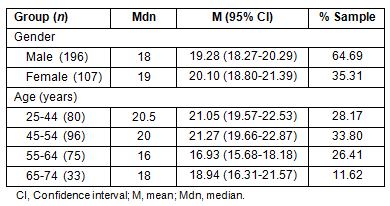
Frequency of coping strategy use
As medians demonstrate (Table 2), the four coping strategies used most commonly by participants were planning; acceptance; active coping; and positive reinterpretation and growth. The strategies employed least frequently were alcohol/drugs, denial, behavioural disengagement and religion.
Table 2: Summary of the coping measures as medians, means and 95% confidence intervals
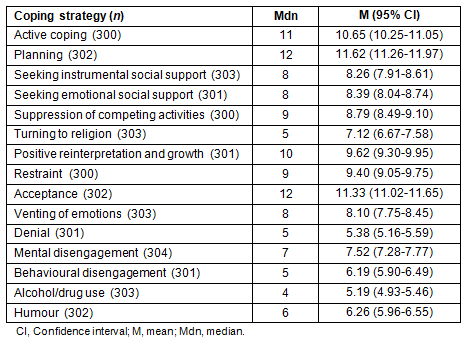
Coping according to gender
Descriptive statistics for the coping strategy measures differentiated by gender, are displayed (Table 3). A Mann-Whitney U-test revealed significantly different levels of venting (6411.50 (z=-5.22), p < .001) (d= .67) and seeking emotional social support (8444.50 (z= -2.26), p < .05) (d= .26) between genders. However, no statistically significant difference in alcohol/drug use between genders was detected.
Table 3: Summary of the coping measures as medians , means, 95% confidence intervals and effect sizes (d) by gender
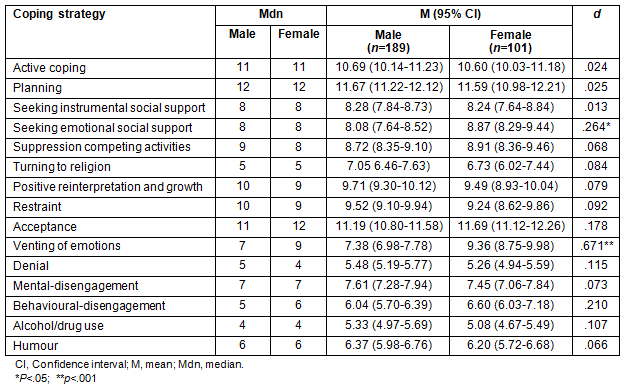
Coping according to age
Descriptive statistics for each of the coping measures by age group are displayed (Table 4). An ANOVA revealed the only differences between the coping strategies employed by various age groups, unlikely to have arisen through sampling error, were in turning to religion (F(3,104.98)= 11.92, p < .001), alcohol/drug use (F(3,133.84)= 6.73, p < .001) and using humour to cope (F(3,128.37)= 7.93, p < .001).
Post-hoc analyses confirmed differences in the use of religion between the 25-44 and 55-64 age groups (d= .87), the 25-44 and 65-74 age groups (d= .86) and the 45-54 and 55-64 age groups (d= .39) with the participants in the 55-64 age group being most likely to use religion. Alcohol/drug use varied between the 25-44 and 45-54 age groups (d= .46), between the 25-44 and 55-64 age groups (d= .61), and between the 25-44 and 65-74 age groups (d= .82) with the youngest group (25-44) being most likely to report using drugs and/or alcohol. Further, the use of humour varied between the 25-44 and 55-64 age groups (d= .43), the 25-44 and 65-74 age groups (d= .70), the 45-54 and 55-64 age groups (d= .49) as well as the 45-54 and 65-74 year old age groups (d= .75). Participants in the two younger groups were more likely to use this strategy than those in the two older groups.
Table 4: Summary of the coping measures as medians, means and 95% confidence intervals by age group
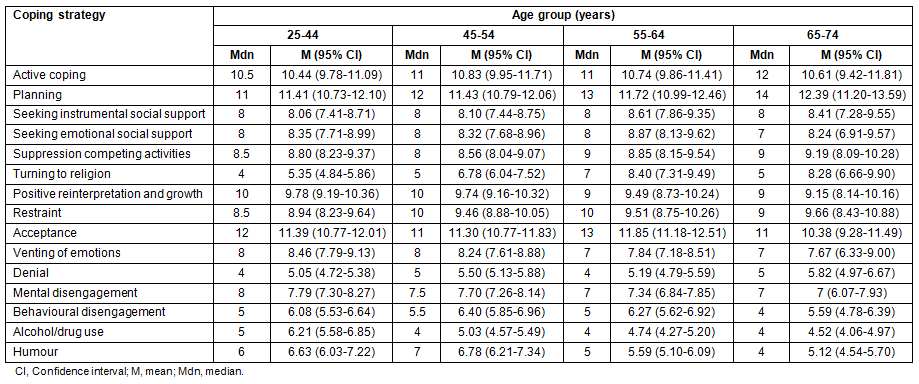
Coping according to type of stressor
Descriptive statistics for coping measures according to stressor type are displayed (Table 5). An ANOVA indicated the only difference unlikely to have arisen through sampling error was with planning (F(2,142.34)=9.39, p < .001). Post-hoc analyses confirmed statistically significant differences exist between the use of planning in the farm and non-farm conditions (d= .48) and between the farm and combination conditions (d= .56). Planning was used most to address farm-related stressors.
Table 5: Summary of the coping measures as medians, means and 95% confidence intervals by type of stressor
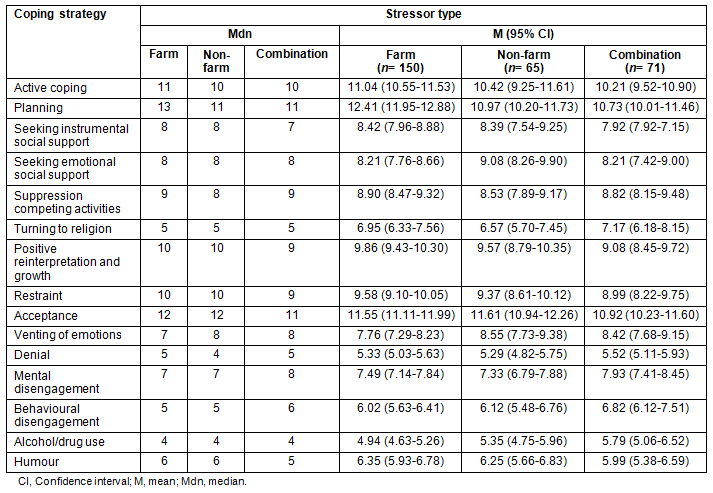
Coping strategies as predictors of psychological distress
A simultaneous multiple regression revealed that behavioural-disengagement (β= .28, p < .05), (β= .20, p < .05), venting (β= .18, p < .05), alcohol/drug use (β= .18, p < .05), and mental disengagement (β= .12, p < .05) were all significant, positive predictors of psychological distress (ie as they increased, so did distress), accounting collectively for 34.6% of its variance (Table 6). Seeking emotional social support was close to being a significant (negative) predictor (β= -.12, p = .06).
Table 6: Summary of the simultaneous regression analysis for
coping measures predicting psychological distress (n=294)
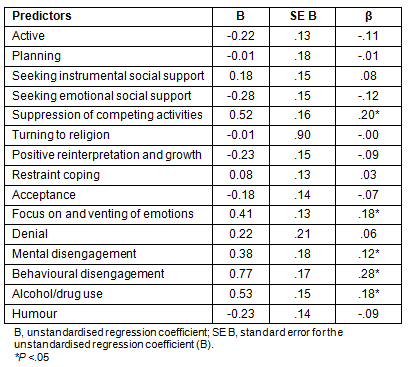
Discussion
The first aim in this research was to determine the age and gender of those most likely to be experiencing high levels of psychological distress in the farming population during drought. The hypothesis that farm women in this sample would be experiencing significantly higher levels of psychological distress than farm men was not supported. This finding is contrary to more general research on the Australian population49, the South Australian population51 and previous research on farmers16, but is consistent with the recent findings of Kilkkinen et al in a substantial rural Australian sample18.
This finding is likely to be relevant to policy makers and mental-health intervention planners; for example, it appears that during a period of drought men and women should be targeted equally with mental-health promotion and prevention initiatives. However, as previous research has consistently found that rates of suicide are significantly higher among farm men54-56, the importance of specialised suicide prevention initiatives for farm men should not be overlooked on the basis of these findings.
The hypothesis that younger farmers (25-44 and 45-54 age groups) would report significantly higher levels of psychological distress than those in the older age groups (55-64 and 65-74 years) was partly supported. There is evidence that those both in the 25-44 and 45-54 age groups were suffering from significantly higher levels of distress than those in the 55-64 age group. A significant difference was not detected, however, between the two younger age groups and the 65-74 age group.
This unexpectedly high level of distress in the 65-74 age group is of particular interest as it directly contradicts Kilkinnen et al's research, which found that among their sample of rural Australians, males in the 65-74 age group had significantly lower levels of psychological distress than all other age groups (significance was not reached for women)18. The limited research that has explored older farmers' stress in the context of drought has found that in addition to experiencing the same pressures as younger farmers, older farmers also report an overwhelming sense of loss and failure19, which suggests the present study's novel finding is likely to be the result of the unique conditions in which it was conducted (ie a time of drought). While retirement is something that farmers in 'normal' circumstances generally look forward to4, older farmers in this context may feel trapped by their current financial situation, and may feel they had failed their ancestors, partners and descendents19-21 and/or worry they are passing on a burden to their children due to uncertain environmental conditions57. This unique finding is worthy of further investigation. Nonetheless, these results largely confirm previous studies' findings of elevated levels of psychological distress in younger farmers and may direct policy-makers and intervention planners to the age groups most in need of assistance.
The second aim of the research was to identify the coping strategies used most and least frequently in the farming population in a time of drought. Farmers reported using planning, acceptance, active coping and positive reinterpretation and growth most and alcohol/drug use, denial, behavioural-disengagement and religion least. These findings are generally consistent with those found by Carver et al in an undergraduate sample27, the only difference being that positive reinterpretation and growth was used more than active coping in the undergraduate sample and less than active coping in the present sample. These results are also generally consistent with the work of Staniford et al who found that when participants were asked to describe the coping strategies they used to deal with stress, two of the themes identified were reframing the problem (ie positive attitude, acceptance, humour) and finding a practical solution58. Intervention planners may use these findings as a guide to the strategies that are commonly accepted by farmers and therefore (if adaptive) may be most easily encouraged.
The third aim in this study was to examine whether farmers' age groups, genders and the type of stressor they encounter, influence their choice of coping strategies. As hypothesised, farm women were found to seek emotional social support and engage in venting as a coping strategy more than farm men, which is consistent with previous coping research27 and the explanations given by some researchers33 to explain higher rates of suicide among men. However, the hypothesis that men would use more alcohol/drugs in an effort to cope was not supported. This finding is surprising, particularly because higher rates of alcohol use among men32 are thought to be major contributors to men's higher rate of suicide33. However, closer examination of the quantity of alcohol/drugs utilised to cope by each gender, such as that undertaken by Brumby et al59, would be useful. Further, differences in the predominant stressors faced by each gender may also help explain some gender differences in coping. Nonetheless, these findings suggest that contrary to stereotypes and research on broader populations (but not the work of Brumby et al59), it is not only farm men who are at risk of engaging in alcohol/drug use as a coping strategy during a drought, but also farm women.
The hypothesis that there would not be any significant differences in the extent to which certain coping strategies were employed between age groups, was not supported. There were, in fact, age differences in the use of turning to religion, alcohol/drug use and the use of humour to cope. Farmers in the 55-64 age group were found to use religion significantly more than younger farmers. Those in the 65-74 age group used religion significantly more than those in the 25-44 age group (but not significantly more than those in other age groups). Furthermore, participants in the 25-44 age group used alcohol/drugs significantly more than the farmers in every other age group. Younger farmers (in both the 24-44 and the 45-54 age groups) were significantly more likely to engage in humour to cope than older farmers (in the 55-64 and 65-74 age groups).
Not only do these findings address a gap in the literature identified by Weigel et al4 on how (or if) farmers' coping alters with age, but they may also give some indication of the age groups that would benefit most from specific interventions. For example, strategies to discourage the use of alcohol/drugs to cope are likely to be most relevant to farmers below 44 years of age.
The analysis then turned to examine whether there may be some association between particular coping strategies and particular types of stressors. As planning (a problem-focused coping style) was used significantly more when dealing with farm-related problems than non-farm-related stressors, the general hypothesis that farm-related stressors would elicit more problem-focused strategies than other stressors was partly supported. The other problem-focused strategies (active coping and suppression of competing activities) were not used significantly more in farm-related contexts. Significantly higher levels of planning were also used in dealing with farm stressors than with combination stressors.
The hypothesis that non-farm-related stressors would elicit more emotion-focused coping strategies than farm-related stressors was not supported. This is contrary to Folkman and Lazarus' findings regarding work versus other contexts28. However, Folkman and Lazarus suggest that in work contexts, people usually expect that something can be done about the problem28, which promotes the use of problem-focused coping, and in other contexts (eg health), people more often see a situation as threatening or harmful, think there are few possibilities for beneficial change, so are likely to use emotion-focused coping. A unique characteristic of this sector is that the farm is generally both a farmer's workplace and home, with many viewing farming not only as an occupation but also as a way of life13,17,38,57. This discrepancy in findings is therefore likely to be a reflection of the intertwined nature of work, home and family roles, the unpredictable nature of farming and possibly a demonstration that farmers perceive both work and other stressors as threatening or harmful (particularly during a drought) with few possibilities for beneficial change, so employ emotion-focused coping equally in both contexts.
Together, these findings demonstrate the importance of testing models of coping on specific populations and to some degree, accounting for the type of stressor being encountered when anticipating or recommending a particular way of coping. That is, it is likely to be easier to encourage farmers to engage in planning when dealing with farm-related stressors than other or combination stressors, but other methods of coping may be encouraged with the same degree of ease across all stressor types. This could have implications for issues such as succession planning which is considered a combination stressor.
The fourth aim in this study was to examine the relationship between particular coping strategies and psychological distress in the drought-affected farming context. Together, in descending order of strength, behavioural disengagement, suppression of competing activities, venting, alcohol/drug use and mental disengagement significantly predicted psychological distress in this sample and accounted for 34.6% of its variance. These strategies were all found to have a positive relationship with psychological distress (ie as they increased, so did levels of distress) in this population. Emotional social support was close to being a significant negative predictor. These findings suggest that coping (particularly maladaptive coping) has a meaningful relationship with psychological distress in this population.
This section of the analysis was exploratory in nature due to the lack of previous research on farmers' coping and the expectation that farmers' coping would be different. However, the finding in this sample that suppression of competing activities was a significant positive predictor of psychological distress, in contrast to Carver et al's conclusion that it is an adaptive strategy among undergraduate students27, is further evidence of the importance of testing models of coping on specific population groups and the dangers in blindly implementing generic coping-enhancement programs. Conversely, the finding of a strong association between avoidant-coping styles (including behavioural-disengagement and alcohol/drug use) and negative wellbeing is consistent with previous research26,29,39,40.
These findings also have important implications for the design of targeted coping-enhancement strategies. While causality cannot be determined from this analysis, given the lack of previous research on this population (particularly during periods of drought) and the evidence that farmers' coping is unique, these findings are helpful in illustrating the types of strategies that should be discouraged in interventions aimed at farmers.
An interesting avenue of further investigation would be to look for differences in the relationships between coping strategies and psychological distress across stressor types (farm, other and combination) in the farming population.
The present study's finding that seeking emotional social support was the negative predictor of distress closest to reaching significance lends support to the value of initiatives designed to bolster social support. Building social support at a community level is consistent with Kenkel's model3 for rural mental-health initiatives and maintaining social contact has been identified as a key factor in fostering resilience and subjective wellbeing among rural communities60,61. The development of social support systems may be of particular benefit to farm men who (as previously discussed), were found to engage in lower levels of emotional social support seeking than farm women. The importance of providing farmers with practical assistance to deal with drought (eg by teaching financial management skills62 and ensuring they have access to essential services such as healthcare facilities59 and rural financial counsellors) also should not be overlooked.
Limitations
Some limitations of the present study should be noted. First, the low response rate may limit the external validity of these findings. Due to cultural factors, the use of self-report measures (particularly the screening measure for psychological distress and self-report of alcohol/drug use) may have resulted in underreporting, although participants' anonymity is likely to have minimised this social desirability effect. Further, the cross-sectional design does not enable accurate assertions to be made about causality which would be useful, as would further investigation into the causal pathways of farmers' particular ways of coping, levels of psychological distress and the role of other personal and contextual variables, in terms of main or buffering effects.
As this study demonstrates, it is often erroneous to assume the universality of coping models which have largely been developed using urban samples. This study has made an important contribution in laying foundations for tailored and relevant coping-enhancement interventions to help farmers more effectively manage future times of drought.
Acknowledgements
The authors gratefully acknowledge the contributions of participants and the recruitment assistance provided by the South Australian Farmers' Federation.
References
1. Somerfield MR, McCrae RR. Stress and coping research: methodological challenges, theoretical advances, and clinical applications. American Psychologist 2000; 55(6): 620-625.
2. Lazarus RS. Coping theory and research: past, present, and future. Psychosomatic Medicine 1993; 55(3): 234-247.
3. Kenkel MB. Stress-coping-support in rural communities: a model for primary prevention. American Journal of Community Psychology 1986; 14(5): 457-478.
4. Weigel RR, Weigel DJ, Blundall J. Stress, coping, and satisfaction: generational differences in farm families. Family Relations 1987; 36(1): 45-48.
5. Judd F, Cooper AM, Fraser C, Davis J. Rural suicide - people or place effects? Australian and New Zealand Journal of Psychiatry 2006; 40(3): 208-216.
6. Lazarus RS, Folkman S. Stress, appraisal and coping. New York: Springer, 1984.
7. Heffernan B, Keogh E, McKew S (Eds). National Farmers' Federation Annual Review 2007-08. Canberra, ACT: National Farmers' Federation, 2008.
8. Alston M, Kent J. Social impacts of drought: a report to NSW Agriculture. Wagga Wagga, NSW: Centre for Rural Social Research, Charles Sturt University, 2004.
9. Sartore GM, Kelly B, Stain HJ. Drought and its effect on mental health - how GPs can help. Australian Family Physician 2007; 36(12): 990-993.
10. Edwards B, Gray M, Hunter B. A sunburnt country: the economic and financial impact of drought on rural and regional families in Australia in an era of climate change. Australian Journal of Labour Economics 2009; 12: 109-131.
11. NSW Farmers' Association. NSW Farmers' Association Submission to Senate Select Committee on mental health. Sydney, NSW: NSW Farmers' Association, 2005.
12. Hennessy K, Fawcett R, Kirono D, Mpelasoka F, Jones D, Bathols J. An assessment of the impact of climate change on the nature and frequency of exceptional climatic events. Canberra, ACT: Commonwealth of Australia, 2008.
13. Gray I, Lawrence G. Predictors of stress among Australian farmers. Australian Journal of Social Issues 1996; 31(2): 173-189.
14. Walker JL, Walker LJS. Self-reported stress symptoms in farmers. Journal of Clinical Psychology 1988; 44(1): 10-16.
15. Booth NJ, Lloyd K. Stress in farmers. International Journal of Social Psychiatry 2000; 46(1): 67-73.
16. Deary IJ, Willock J, McGregor M. Stress in farming. Stress Medicine 1997; 13(2): 131-136.
17. Gregoire A. The mental health of farmers. Occupational Medicine 2002; 52(8): 471-476.
18. Kilkkinen A, Kao-philpot A, O'Neil A, Philpot B, Reddy P, Bunker S et al. Prevalence of psychological distress, anxiety and depression in rural communities in Australia. Australian Journal of Rural Health 2007; 15(2): 114-119.
19. Polain JD, Berry J, Hoskin JO. Rapid change, climate adversity and the next 'Big Dry': older farmers' mental health. Australian Journal of Rural Health 2011; 19: 239-243.
20. Hart CR, Berry HL, Tonna AM. Improving the mental health of rural New South Wales communities facing drought and other adversities. Australian Journal of Rural Health 2011; 19: 231-238.
21. Sobels JD. The social impacts on the Lower Murray and Lakes region during 2007-08 of another year of low river flows. (Online) 2007. Available: http://www.rdamr.org.au/fileadmin/user_upload/Murraylands/Docs/Social_Impacts_of_the_Drought_R2.pdf (Accessed 30 December 2012).
22. Roufeil L, Lipzker A.Psychology services in rural and remote Australia. InPsych 2007; 29: 8-11.
23. Elgar FJ, Arlett C, Groves R. Stress, coping, and behavioural problems among rural and urban adolescents. Journal of Adolescence 2003; 26(5): 577-588.
24. DeLongis A, Holtzman S. Coping in context: the role of stress, social support, and personality in coping. Journal of Personality 2005; 73(6): 1633-1656.
25. Judd F, Jackson H, Fraser C, Murray G, Robins G, Komiti A et al. Understanding suicide in Australian farmers. Social Psychiatry and Psychiatric Epidemiology 2006; 41(1): 1-10.
26. Billings AG, Moos RH. The role of coping responses and social resources in attenuating the stress of life events. Journal of Behavioral Medicine 1981; 4(2): 139-157.
27. Carver CS, Scheier MF, Weintraub KJ. Assessing coping strategies: a theoretically based approach. Journal of Personality and Social Psychology 1989; 56(2): 267-283.
28. Folkman S, Lazarus RS. An analysis of coping in a middle-aged community sample. Journal of Health and Social Behavior 1980; 21(3): 219-239.
29. Ingledew DK, Hardy L, Cooper CL. Do resources bolster coping and does coping buffer stress? An organizational study with longitudinal aspect and control for negative affectivity. Journal of Occupational Health Psychology 1997; 2(2): 118-133.
30. Möller-Leimkühler AM. Barriers to help-seeking by men: a review of sociocultural and clinical literature with particular reference to depression. Journal of Affective Disorders 2002; 71(1-3): 1-9.
31. Pearlin LI, Schooler C. The structure of coping. Journal of Health and Social Behavior 1978; 19(1): 2-21.
32. Brumby SA, Kennedy AJ, Mellor D, McCabe MP, Ricciardelli LA, Head A et al. The Alcohol Intervention Training Program (AITP): A response to alcohol misuse in the farming community. BMC Public Health 2011; 10: 242.
33. Möller-Leimkühler AM. The gender gap in suicide and premature death or: why are men so vulnerable? European Archives of Psychiatry and Clinical Neuroscience 2003; 253(1): 1-8.
34. Sayers MR, Miller KM. Help-seeking behaviours of suicidal men aged 17-35 years: a consumer consultation and participation pilot project. Perth, WA: Ministerial Council for Suicide Prevention, 2004.
35. Aldwin CM, Park CL. Coping and physical health outcomes: an overview. Psychology and Health 2004; 19(3): 277-281.
36. Folkman S. An approach to the measurement of coping. Journal of Occupational Behaviour 1982; 3: 95-107.
37. O'Brien TB, DeLongis A.The interactional context of problem-, emotion-, and relationship-focused coping: the role of the Big Five personality factors. Journal of Personality 1996; 64(4): 775-813.
38. Fraser CE, Smith KB, Judd F, Humphreys JS, Fragar LJ, Henderson A et al. Farming and mental health problems and mental illness. International Journal of Social Psychiatry 2005; 51(4): 340-349.
39. Anderson DG. Coping strategies and burnout among veteran child protection workers. Child Abuse and Neglect 2000; 24(6): 839-848.
40. Littleton H, Horsley S, John S, Nelson DV et al. Trauma coping strategies and psychological distress: a meta-analysis. Journal of Traumatic Stress 2007; 20(6): 977-988.
41. Mytko JJ, Knight SJ, Chastain D, Mumby PB, Siston AK, Williams S. Coping strategies and psychological distress in cancer patients before autologous Bone Marrow Transplant. Journal of Clinical Psychology in Medical Settings 1996; 3(4): 355-366.
42. Stein JA, Rotheram-Borus MJ. Cross-sectional and longitudinal associations in coping strategies and physical health outcomes among HIV-positive youth. Psychology and Health 2004; 19(3): 321-336.
43. Aldwin CM, Revenson TA. Does coping help? A reexamination of the relation between coping and mental health. Journal of Personality and Social Psychology 1987; 53(2): 337-348.
44. LeSergent CM, Haney CJ. Rural hospital nurse's stressors and coping strategies: a survey. International Journal of Nursing Studies 2005; 42(3): 315-324.
45. Department of Agriculture Fisheries and Forestry. Exceptional Circumstances Handbook. (Online) 2010. Available: http://www.daff.gov.au/agriculture-food/drought/ec/ec_handbook#criteria (Accessed 13 May 2012).
46. Andrews GT. Slade Interpreting scores on the Kessler Psychological Distress Scale (K10). Australian and New Zealand Journal of Public Health 2001; 25(6): 494-497.
47. Kessler RC, Andrews G, Colpe LJ, Hiripi E, Mroczek DK, Normand SLT et al. Short screening scales to monitor population prevalences and trends in non-specific psychological distress. Psychological Medicine 2002; 32(6): 959-976.
48. Furukawa TA , Kessler RC, Slade T, Andrews G. The performance of the K6 and K10 screening scales for psychological distress in the Australian National Survey of Mental Health and Well-Being. Psychological Medicine 2003; 33(2): 357-362.
49. Australian Bureau of Statistics. National Health Survey: summary of results, 2004-05. Canberra, ACT: Australian Bureau of Statistics, 2006.
50. Eckert KA, Taylor AW, Wilkinson DD, Tucker GR. How does mental health status relate to accessibility and remoteness? Medical Journal of Australia 2004; 181(10): 540-543.
51. South Australian Department of Health. Brief report: psychological distress in SA as measured by the Kessler 10. Population Research and Outcome Studies. Adelaide, SA: South Australian Department of Health, 2005.
52. Folkman S, Lazarus RS. Ways of coping questionnaire permissions set, manual, test booklet, scoring key. Palo Alto, CA: Consulting Psychologists Press, 1988.
53. Cohen J. Statistical power analysis for the behavioural sciences. New York: Academic Press, 1977.
54. Booth NJ, Briscoe M, Powell R. Suicide in the farming community: methods used and contact with health services. Journal of Occupational and Environmental Medicine 2000; 57: 642-644.
55. Miller KC. Burns Suicides on farms in South Australia, 1997-2001. Australian Journal of Rural Health 2008; 16(6): 327-331.
56. Page AN, Fragar JL. Suicide in Australian farming, 1988-1997. Australian and New Zealand Journal of Psychiatry 2002; 36(1): 81-85.
57. Sartore GM, Kelly B, Stain H, Albrecht G, Higginbotham N et al. Control, uncertainty, and expectations for the future: a qualitative study of the impact of drought on a rural Australian community. Rural and Remote Health 8(3): 950. (Online) 2008. Available: www.rrh.org.au (Accessed 13 September 2012).
58. Staniford AK, Dollard MF, Guerin B. Stress and help-seeking for drought-stricken citrus growers in the Riverland of South Australia. Australian Journal of Rural Health 2009; 17: 147-154.
59. Brumby SA, Willder SJ, Martin J.The sustainable farm families project: changing attitudes to health. Rural and Remote Health 9(1): 1012. (Online) 2009. Available: www.rrh.org.au (Accessed 13 September 2012).
60. Greenhill J, King D, Lane A, MacDougall C. Understanding resilience in South Australian farm families. Rural Society 2009; 19(4): 318-325.
61. Kutek S, Turnbull MD, Fairweather-Schmidt AK. Rural men's subjective well-being and the role of social support and sense of community: evidence for the potential benefit of enhancing informal networks. Australian Journal of Rural Health 2011; 19: 20-26.
62. Olson KR, Schellenberg RP. Farm stressors. American Journal of Community Psychology 1986; 14(5): 555-569.



